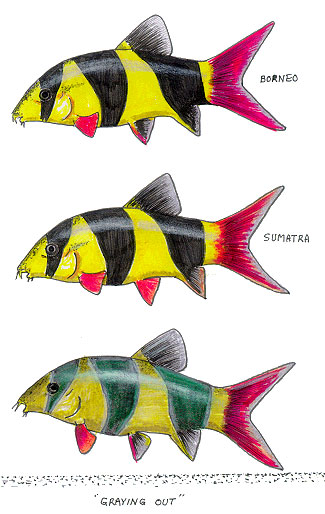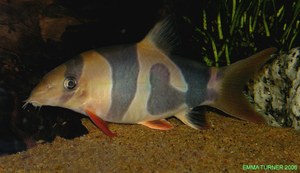Clown Loach Coloration & Marking Variations
The reasons for this article
Throughout the Loaches On-Line Web Forum, there are repeated questions and discussions about Clown Loach coloring and markings. I've tried to collate this information in order that people can better understand the differences discussed. A picture speaks a thousand words, so I've tried to illustrate the regional color variations seen in the species, plus an example of a fish "Graying Out" as we've come to call this particular appearance. The only limitation on accuracy here is my colored pens and how accurately the picture scans. However, it should provide a useful guide. Some fish exhibit stripe patterns that are very different to the accepted "norm", and I've tried to illustrate the basic pattern differences.
Regional Color Variation

Clown Loaches are found throughout Borneo and Sumatra. Due to regionally separated breeding groups, certain bio-diversity has lead to distinct differences which may not be particularly noticeable until you place two fish from different areas beside one another. Fish from Borneo, in all the examples I've seen, tend to be overall less colorful than fish from Sumatra. Sumatran fish seem to have a "glow" about them.
I would say that the quickest ID could be made by looking at the color of the pelvic fins. Fish from Borneo have a black area in the base and center of the fin, and usually the front (hard) ray is red/orange in color, with the end of the fin being clear, smoky, or slightly red, whilst in Sumatran fish the fin is all red/orange.
Other differences are that the Dorsal and Anal fins have less yellow at their lead edges in Sumatran fish. Also the rear stripe extends onto the Caudal Peduncle in Borneo fish, but not in Sumatran. Sumatran's tend to have some redness from the Caudal extending into the Caudal Peduncle.
Clowns also come from Kalimantan, and the fish from here are basically like Sumatrans, but have more intense red coloration. The source article for this information states that Sumatran fish have a kind of silver sheen to the body not seen in Kalimantan fish.
"Graying Out"
This is a term we've come to use here as a description of one particular color mode seen in our fish. New owners of Clowns are always posting panicked messages, assuming that there's something drastically wrong with their new fish. Usually, there is no problem at all.
Clowns are able to change their coloration within certain parameters. These changes can be based on mood, aggression, possibly stress and other factors. The illustration shows a fish sitting at a slight tail-down attitude with fins spread. This position will often be taken accompanied by "graying out", during mock fights between Clowns. These fights are often referred to as "Sparring", and are used to determine the natural pecking order within a group. People have theorized that "gray" fish are sub-dominant when they remain this color for prolonged periods, but I have noticed that my Dominant (Alpha) fish is often the one showing this color. They can change from regular coloration to "gray" quite quickly, particularly at feeding time, when many squabbles break out. Depending on one's tank lighting, this color change may show a kind of greenish, metallic sheen to the whole body, most noticeable over the stripes. The edges of the stripes tend to have a sort of paler area than the rest of the stripe.
 |
This is a typical tone of "graying out". Note the light edging on the normally black stripes. Color changes extend into the fins. |
Below are a series of photographs taken during an altercation between two Clown Loaches. Note the variations in color throughout the fight and various scratches visible on their bodies.
 |
Left hand fish was former "Alpha" fish but was usurped a few years ago. Note damage to fins which never healed properly after that fight for dominance. The other fish is the current "Alpha" in the group. |
 |
Note the fish's open mouth. Respiration rate increases dramatically during these fights. The spread fins is a typical pose, possibly to make the fish look larger and more intimidating. |
 |
The fish will posture beside one another in an attempt to make the other back down without actual physical combat. |
 |
The Alpha fish will usually be noticeably further from the normal coloration than the other. |
 |
Eventually, the fish may rush at one another and may lock jaws momentarily. Again, this is a trial of strength. |
 |
The Alpha very grayed out. |
 |
Note scratches visible on its sides. The dark scratches are marks and algae on the aquarium glass. |
 |
Another piece of physical contact. Note the front fish is now somewhat closer to normal in color. This is a sign that it is losing the battle and about to back down from the conflict. |
 |
At this point, the conflict is almost over. |
Stripe Variations
The vast majority of Clowns we see have a "Classic" stripe pattern as in the color drawings. However, once in a while, some fairly funky variations are seen. These are just genetic variations that throw up odd patterns. I've illustrated the most common variations that I've seen. They seem to fall into 6 basic categories, but variations in marking sizes, plus combinations of the patterns shown are almost certain to occur. These fish can provide their owner with a readily identifiable fish that can only add to the cuteness of the pet by its uniqueness.
I've taken it upon myself to give the variations a name, so that any future talk of a particular pattern might be clearer once everyone's memorized them. However, if anyone has better suggestions for a name for any particular pattern, they can be changed.
![]()
| A.) "Jigsaw" I'd call this a second stripe Jigsaw, as the stripe looks like a Jigsaw piece  |
B.) "3rd Stripe Fragmentation"  |
| C.) "2nd Stripe, Top & Bottom Spot" Spot on back and belly.  |
D.) "Saddle" 2nd stripe only over back like a saddle. |
E.) "Side Spot" Self-explanatory. |
F.) "1-2 Join" 1st & 2nd stripes joined at top. |
![]()
Photos of Clown Loaches with unusual markings:
 |
 |
 |
 |
 |
 |
 |
 |

Document Actions

